Intermittent Rough Engine / High EGT need help diagnosing
-
Members Online
- wood_fly
- TX-Champ
- eman1200
- Fly Boomer
- Robm
- bluehighwayflyer
- ChuckSchneider
- DXB
- hobbit64
- exM20K
- TCC
- Rick Junkin
- Rmnpilot
- tperkins92
- kortopates
- Jeff Uphoff
- Deb
- takair
- PT20J
- Mooney in Oz
- N911TP
- Justin Schmidt
- Alan Maurer
- raymondscott0321
- Ibra
- Robert Hicks
- Sabremech
- banjo
- Farmboy561
- Twing207
- Dwb62
- mike_elliott
- alexz
- MIRICYL Baby
- Kirch56H


Recommended Posts
Join the conversation
You can post now and register later. If you have an account, sign in now to post with your account.